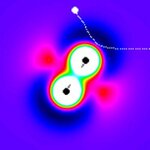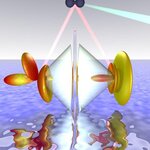Physics

It’s Physics World time again, folks!
This month’s (July 2008) issue has a cover headline “On reflection: Symmetry and the Standard Model”, and a diagram of the 8-dimensional E8 group squashed flat like a beached jellyfish on the 2-dimensional page. The article itself (by Stephen Maxfield of Liverpool University) is as good a summary of the development the Standard Model as I’ve come across, and does serve to persuade me that those guys, by and large, really do know what they’re talking about. But what are they talking about? As in Wikipedia when they say such things as “Rotating a spin-1/…

We all know what happens when cars collide on the freeway or an anvil lands on Wile E. Coyote's head - physics at the macro level is predictable. But what about a single hydrogen atom and a lone molecule of deuterium, the smallest atom and one of the smallest molecules?
When an atom collides with a molecule, traditional wisdom said the atom had to strike one end of the molecule hard to deliver energy to it. People thought a glancing blow from an atom would be useless in terms of energy transfer, but that turns out not to be the case, according to the researchers.
Every atom or molecule, even…

When lasers illuminate material it usually warms up, so laser beams are used for cutting sheet steel, for welding or even as scalpels. But this effect can also be reversed. When the frequency of the laser beam makes the irradiated material just not absorbing its light and slightly more energy (of the photons, as physicists call the light particles) is needed for that, this photons “take” this missing energy from the oscillation energy of the material’s atoms.
Such oscillation energy (“phonons”) is equivalent to the vibration of atoms which is also called temperature and which is slightly…

Researchers from the Physikalisches Institut of the University of Stuttgart have create entangled quantum states in diamond, which means there is finally a diamond men care about - namely the one that might some day be inside a quantum computer working at room temperature, a feat so far considered impossible for other materials.
While physicists have long described the world of atoms by quantum mechanics, one of its strangest characteristics, and the one that defies easy description, allows the linking of two objects without any noticeable interaction over a distance.
Einstein called this a…

The last time you had a cappuccino, did you think 'I bet I can learn something about type-I superconductors here?' Well, a team of Ames Laboratory physicists did and have found that the bubble-like arrangement of magnetic domains in superconducting lead exhibits patterns that are very similar to everyday froths like soap foam or frothed milk on a fancy coffee.
The similarities between the polygonal-shaped patterns in conventional foams and "suprafroths," the patterns created by a magnetic field in a superconductor, establish suprafroths as a model system for the study of froths.
Ruslan…

Don't put a down payment on that invisible plane just yet but a team of scientists from Boston College and Duke University developed a highly-engineered metamaterial capable of absorbing all of the light that strikes it – to a scientific standard of perfection.
The metamaterial uses tiny geometric surface features to successfully capture the electric and magnetic properties of a microwave to the point of total absorption.
The group used computer simulations based on prior research findings in the field to design resonators able to couple individually to electric and magnetic fields to…

A research team working at the National Institute of Standards and Technology (NIST) has found an explanation for the extreme sensitivity to mechanical pressure or voltage of a special class of solid materials called relaxors. The ability to control and tailor this sensitivity would allow industry to enhance a range of devices used in medical ultrasound imaging, loudspeakers, sonar and computer hard drives.
Relaxors are highly sensitive piezoelectrics — they change shape when a battery is connected across opposite ends of the material, or they produce a voltage when squeezed.
“Relaxors are…

When atoms form molecules, they share their outer electrons and this creates a negatively charged cloud. The electrons buzz around between the two positively charged nuclei, making it impossible to tell which nucleus they belong to. They are delocalized.
Is this also true for the electrons located closer to the nucleus? And are those electrons spread out too, or do they belong to just one nucleus, i.e. are they localized?
These questions have been hotly debated for the last 50 years, and an international team of scientists says they have an answer - in true quantum theory fashion, they are…

Physicists at Penn State say they have provided a mechanism by which information can be recovered from black holes; objects from which, according to Einstein's theory of general relativity, not even light can escape. The team's findings pave the way toward ending a decades-long debate sparked by renowned physicist Steven Hawking.
In the 1970s, Hawking stated that black holes evaporate by quantum processes; however, he asserted that information, such as the identity of matter that is gobbled up by black holes, is permanently lost. At the time, Hawking's assertion threatened to turn quantum…

For the first time, physicists have come up with a scheme that would allow a quantum mechanical expert to win every time in a con game with a victim who only knows about classical physics. Prior quantum cons have typically been vulnerable to simple countermeasures.
A pair of physicists at Tel-Aviv University in Israel came up with the quantum cheat by imagining two people betting on the location of a particle hidden among a set of boxes. In the game, a quantum mechanical con artist named Alice turns away as her classical victim, Bob, is allowed to look inside one of two boxes sitting on a…